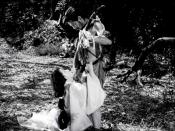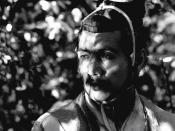PSYCHOLOGICAL ANALYSIS OF RASHOMAN English 161, Chris Evans Submitted by Joe Rousseau Rashomon, by Ryunosaki Akutaguya provides great insight into the psychological discord that the Japanese culture was undergoing in the early part of the twentieth century. Japan was in the throes of a societal transformation, from a traditional, religious-based society, to a newly adopted weternized culture. Japan was rapidly assimilating industrial and scientific techniques and philosophies that were in conflict with, and were replacing traditional ways of life. Akutaguwa illustrates this with his opening two paragraphs where he shows the once proud and majestic Rashomon Gate, a religious monument, abandoned and in ruins. As we enter the story, it is raining, (symbolic of transformation or rebirth) and the author describes the city of Kyoto having undergone a series of calamities; earthquakes, fires and tornadoes which have left Kyoto in a state of decline. This image is put side by side with the Samurai?s servant, whose master, once prosperous, is wealthy no longer.
The servant, therefore, has been discharged and is out on the street. Psychologically, the imagery of the first two paragraphs is important. The religious artifacts, once richly decorated with gold and silver, no longer proudly represent old Japan. The gold and silver has ?worn off? and the statues, which themselves represent the collectivist mindset and values, are being chopped up and ?sold? as firewood. This represents a westernized psychological mindset that everything is for sale, including the Japanese people?s once- idealized values. The Rashomon itself is now a repository for the Kyoto dead, symbolically, those who cannot adapt to the new psychology and values taking over Japan.
The current states of the city and the Rashomon Gate sets the stage for the servant?s internal psychological struggle. We meet the servant, his once fine clothes are...


